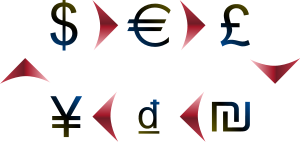n the forex market, you buy or sell currencies.
Placing a trade in the foreign exchange market is simple: the mechanics of a trade are very similar to those found in other markets (like the stock market), so if you have any experience in trading, you should be able to pick it up pretty quickly.
The object of forex trading is to exchange one currency for another in the expectation that the price will change, so that the currency you bought will increase in value compared to the one you sold.
Example:
Trader's Action
EUR
USD
You purchase 10,000 euros at the EUR/USD exchange rate of 1.1800
+10,000
-11,800
Two weeks later, you exchange your 10,000 euros back into U.S. dollar at the exchange rate of 1.2500
-10,000
+12,500**
You earn a profit of $700
0
+700
*EUR 10,000 x 1.18 = US $11,800
** EUR 10,000 x 1.25 = US $12,500
An exchange rate is simply the ratio of one currency valued against another currency. For example, the USD/CHF exchange rate indicates how many U.S. dollars can purchase one Swiss franc, or how many Swiss francs you need to buy one U.S. dollar.
How to Read a Forex Quote
Currencies are always quoted in pairs, such as GBP/USD or USD/JPY. The reason they are quoted in pairs is because in every foreign exchange transaction, you are simultaneously buying one currency and selling another. Here is an example of a foreign exchange rate for the British pound versus the U.S. dollar:
The first listed currency to the left of the slash ("/") is known as the base currency (in this example, the British pound), while the second one on the right is called the counter or quote currency (in this example, the U.S. dollar).
When buying, the exchange rate tells you how much you have to pay in units of the quote currency to buy one unit of the base currency. In the example above, you have to pay 1.51258 U.S. dollars to buy 1 British pound.
When selling, the exchange rate tells you how many units of the quote currency you get for selling one unit of the base currency. In the example above, you will receive 1.51258 U.S. dollars when you sell 1 British pound.
The base currency is the "basis" for the buy or the sell. If you buy EUR/USD this simply means that you are buying the base currency and simultaneously selling the quote currency. In caveman talk, "buy EUR, sell USD."
You would buy the pair if you believe the base currency will appreciate (gain value) relative to the quote currency. You would sell the pair if you think the base currency will depreciate (lose value) relative to the quote currency.
Long/Short
First, you should determine whether you want to buy or sell.
If you want to buy (which actually means buy the base currency and sell the quote currency), you want the base currency to rise in value and then you would sell it back at a higher price. In trader's talk, this is called "going long" or taking a "long position." Just remember: long = buy.
If you want to sell (which actually means sell the base currency and buy the quote currency), you want the base currency to fall in value and then you would buy it back at a lower price. This is called "going short" or taking a "short position". Just remember: short = sell.
"I'm long AND short."
Bid/Ask
"How come I keep getting quoted with two prices?"
All forex quotes are quoted with two prices: the bid and ask. For the most part, the bid is lower than the ask price.
The bid is the price at which your broker is willing to buy the base currency in exchange for the quote currency. This means the bid is the best available price at which you (the trader) will sell to the market.
The ask is the price at which your broker will sell the base currency in exchange for the quote currency. This means the ask price is the best available price at which you will buy from the market. Another word for ask is the offer price.
The difference between the bid and the ask price is popularly known as the spread.
On the EUR/USD quote above, the bid price is 1.34568 and the ask price is 1.34588. Look at how this broker makes it so easy for you to trade away your money.
If you want to sell EUR, you click "Sell" and you will sell euros at 1.34568. If you want to buy EUR, you click "Buy" and you will buy euros at 1.34588.
Now let's take a look at some samples.
 Image via Wikipedia
Image via Wikipedia





